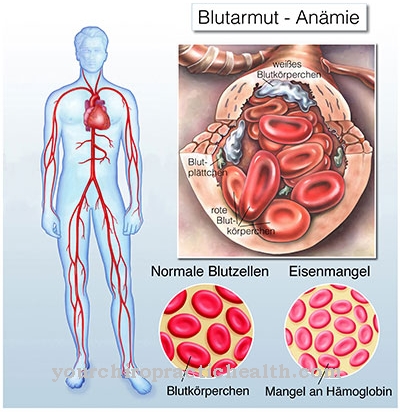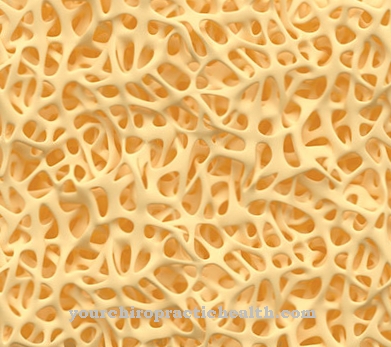Wilson disease is a genetic copper storage disease based on a genetic defect. Copper can no longer be excreted regularly, deposits induce severe damage. The liver, eyes and brain are mainly affected. If left untreated, Wilson's disease is fatal.
What is Wilson disease?

© Yulia Furman - stock.adobe.com
Wilson disease is a relatively rare, hereditary, metabolic disease and is also known under the names "copper storage disease", "Wilson disease" or "pseudosclerosis Westphal". Wilson's disease was named after the British neurologist Samuel A. K. Wilson (1878-1937).
One or more gene mutations disrupt the copper metabolism in the liver of those affected. Absorbed copper cannot be removed naturally, it binds and is deposited in the organism.
The course of the disease is characterized by a multitude of symptoms, which are mainly manifested in liver damage and neurological abnormalities. The frequency of the genetic defect is around 1: 30,000.
causes
The cause of Wilson disease takes place due to a genetic defect on the 13th chromosome. The so-called “Wilson gene” is inherited in an autosomal recessive manner, whereby the father and / or mother themselves do not have to be sick, but are only carriers of the defective genetic makeup.
Wilson's disease occurs more frequently in related marriages. If you fall ill with Wilson's disease, there is a disorder of the copper metabolism because the transport route of the copper from the liver to the bile is impaired. Excess copper absorbed with daily food and excess copper cannot be transported by the liver cells into the bile and excreted with the stool, but is deposited in the liver.
There it causes inflammatory reactions that can lead to liver cirrhosis. Furthermore, the deposited copper reaches the entire organism from the liver. The liver, the cornea of the eye, the brain and the central nervous system are mainly affected by copper deposits. The excessive copper level damages the affected cells and limits their tasks and functions.
Symptoms, ailments & signs
With Wilson's disease, very different, mostly unspecific symptoms can occur. These include tiredness, loss of appetite, exhaustion, depression, mood swings, abdominal pain, frequent bruises or problems with body coordination. How the disease manifests itself in individual cases depends on which organs and areas of the body are affected by the disturbed copper metabolism.
In most cases, the first symptoms of the disease appear between the ages of 13 and 24 years. However, this can also be the case significantly earlier or later. The consequences of liver damage are often evident even in young patients. This can lead to an enlarged liver, hepatitis, fatty liver disease and, in an advanced stage, cirrhosis of the liver.
Wilson's disease can lead to yellowing of the skin and mucous membranes (jaundice). The eyes are also often affected by the disease. The so-called Kayser-Fleischer corneal ring is characteristic of Wilson's disease. It is a noticeable change in the cornea, which is noticeable by a golden brown to greenish ring around the iris.
Night blindness, strabismus and inflammation of the optic nerve are also common. Similar to Parkinson's or Huntington's disease, neurological symptoms such as muscle stiffness, uncontrolled muscle movements, tremors, slow movements, epileptic seizures, and writing and speaking disorders often occur.
Diagnosis & course
A general distinction is made between Wilson disease between the juvenile type, in which the disease begins between the ages of 5 and 20 and if left untreated, progresses rapidly to death, and the adult type, in which Wilson's disease is only diagnosed between the ages of 20 and 40, and a slower one Course is marked.
In childhood, the final diagnosis is often preceded by hepatic symptoms (gastrointestinal disorders, liver damage). In adulthood, the first symptoms appear mainly through neurological deficits (speech and swallowing disorders, tremors) and psychiatric abnormalities (psychosis, behavioral disorder).
The clinical picture often manifests itself relatively early in liver disorders. In patients with neurological symptoms, an ophthalmological examination with a slit lamp often reveals the Kayser-Fleischer corneal ring, which is caused by copper deposits in the eye. A final diagnosis is made by blood tests in which the copper metabolism is examined.
If there is a low serum ceruloplasmin value in combination with an increased copper excretion value in the urine, Wilson's disease is considered confirmed. Additional security is gained through intravenous copper testing, penicillamine stress testing, and genetic testing.
Complications
Wilson's disease causes various complaints and limitations in the patient. In most cases, however, the disease negatively affects the brain, liver, and eyes. Those affected suffer mainly from fatty liver and thus from liver cirrhosis as the disease progresses.
There is a tremor of the hands and a general adeptness and forgetfulness. The patient's everyday life is significantly restricted by Wilson's disease. The patients can hardly see anything at night, although the visual disturbances can also show up during the day. These complaints often lead to psychological complaints and depression.
The disease can also lead to a behavioral disorder. Furthermore, there are also swallowing difficulties, which make normal intake of liquids and food significantly more difficult. The disease also has a negative effect on the coordination and orientation of the person affected.
Treatment of the disease can be done relatively easily with various drugs. There are no particular complications and the symptoms can be well limited.Successful treatment of Wilson's disease also does not lead to a reduction in life expectancy.
When should you go to the doctor?
The signs of Wilson's disease are varied and affect different areas. If there are physical complaints such as abdominal pain, a general malaise or a decrease in performance, a doctor's visit is necessary. If there is swelling on the upper body, changes in breathing activity or noise development during digestion, there is an irregularity that must be examined and clarified. Changes in the appearance of the skin, the development of pimples or the formation of bruises are signs of an existing disease. If the physical movements can no longer be coordinated as usual, the person concerned needs medical help. Various tests are required to clarify the cause.
If, in addition to the physical irregularities, there are also emotional or mental stresses, a visit to the doctor is also recommended. If there are noticeable fluctuations in mood, an aggressive demeanor or withdrawal from social life, a doctor should be informed of the observations. If it comes to depressive states, a loss of well-being as well as the general joy of life, there is a need for action. If the symptoms persist for several weeks or months, a doctor or therapist should be consulted. If the daily obligations can no longer be fulfilled due to the complaints, there is an urgent need for action.
Treatment & Therapy
To counteract the copper deposits, every form of therapy has Wilson disease the aim of removing copper from the body and removing stored copper. Since Wilson's disease is based on a genetic defect, consistent and, above all, lifelong therapy is necessary.
The disease cannot be cured, but it can be treated with suitable therapy concepts. Existing therapy must not be discontinued during pregnancy either, as this can lead to a new flare-up of the disease with consequent liver damage. Medicines that bind copper, so-called chelating agents, serve to remove stored copper or to maintain a balanced copper balance.
D-penicillamine, trientine or ammonium tetrathiomolybdate are often used. Treatment with zinc salts binds copper in the intestinal mucosa and prevents it from entering the body. Zinc salt treatments are often prescribed in combination with D-penicillamine. Food that has a high copper content (chocolate, whole grain products, mushrooms) should be avoided with a diet that is low in copper.
Taking vitamin E and avoiding contact with copper (cookware, copper water pipes) are useful accompanying measures. If there is already severe liver damage as a result of the disease, a liver transplant is the last form of treatment. The procedure carries many risks and requires lifelong immunosuppression. Innovative treatment options such as liver cell transplants are already being tested in animal experiments.
Outlook & forecast
If left untreated, Wilson's disease is always fatal. Death usually occurs from liver or kidney failure and can occur within two to seven years. This is likely if the condition manifests itself in early childhood. A different course, which mainly involves neurological involvement, can only be fatal after decades. However, there is a mortality rate of almost 100 percent for all those affected without treatment.
If treatment is started early, Wilson's disease can be almost completely compensated. There is no risk of damage from the genetic disease, nor is life expectancy restricted. A long and healthy life with Wilson's disease is possible thanks to medical care.
Even in patients who have already suffered damage, these are partially reversible through therapy. This applies to recent neuronal damage as well as liver damage. The symptoms can be improved in a good three quarters of all patients. People who have liver problems as a result of Wilson's disease are better treated than those with neurological symptoms. However, the copper storage disease cannot be cured and is also hereditary. Family members should be examined for this at an early stage.
prevention
Prevention of the disease is not possible because it is a genetic defect. The clinical picture occurs in the relationship Wilson disease on, it is advisable to have yourself tested in order to take any therapeutic measures in good time. If the diagnosis is made very early, possible damage can be suppressed with medication. Parents who are not directly affected can also be carriers of the disease.
Aftercare
In the majority of cases, those affected have only a few and only limited direct follow-up measures available. The person concerned should therefore ideally contact a doctor at an early stage so that no further complications and complaints can arise. As a rule, the sooner a doctor is consulted, the better the further course of the disease will be.
Due to the genetic origin of the disease, it cannot be completely cured. Those affected should therefore seek genetic testing and advice if they wish to have children in order to prevent the disease from recurring. Most patients typically rely on various medications to be taken.
The person concerned should always observe the prescribed dosage and regular intake in order to relieve the symptoms permanently and correctly. If anything is unclear or if you have any questions, you should always consult a doctor first. Furthermore, those affected by Wilson's disease are always dependent on regular checks and examinations by a doctor. If there should be an operation in the life of the person concerned, the disease must definitely be mentioned.
You can do that yourself
The primary need for people with Wilson's disease is to change their diet. The aim of the treatment is to remove the copper from the body. This can be achieved through an appropriate diet that is rich in driving substances. Typical digestive products such as banana and asparagus, but also special diuretic teas from the drugstore, have proven themselves. In general, the sick should drink a lot, ideally mineral water, herbal teas or spritzers.
In addition, drugs that bind the copper must be taken. These chelating agents can cause various side effects and interactions, which is why a doctor should be consulted regularly during therapy.
If there is already severe liver damage, a liver transplant is necessary. After such an operation, the person concerned needs rest and bed rest. Regular visits to the doctor are also required here. Drug treatment is usually also necessary. The therapy must be regularly adapted to the respective constitution of the patient.
Since a difficult course also represents an enormous emotional burden, the person affected usually needs therapeutic support. If desired, the psychologist can also establish contact with other affected persons or a self-help group and thus support the patient in coping with the disease.








.jpg)



















